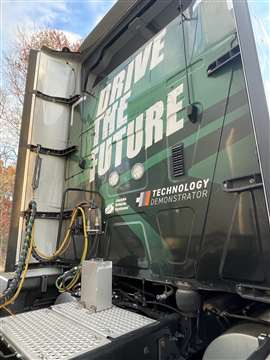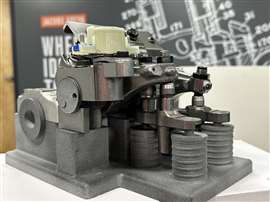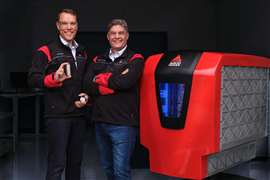Read this article in Français Deutsch Italiano Português Español
Savings through cylinder deactivation
10 February 2025
 Cummins Valvetrain Technologies demo truck used for real-world CDA testing (Photo: Cummins)
Cummins Valvetrain Technologies demo truck used for real-world CDA testing (Photo: Cummins)Delays in rolling out charging infrastructure in key markets and high prices for battery-electric vehicles mean that many truck operators will continue to choose diesel power for as long as they are able.
But this does not mean OEMs can cut powertrain research and development. Far from it. Impending environmental legislation in North America (EPA 27) and Europe (Euro 7) have engine designers working harder than ever to achieve greater efficiencies.
Working from a 2019 baseline, the EU will require vehicles to have a 45% reduction in CO2 by 2030. This will rise to 56% by 2035 and 90% by 2040, using the theoretical VECTO measuring tool which incorporates such factors as aerodynamics and rolling resistance with fuel consumption and exhaust output to calculate CO2 emissions.
In developing new strategies, engine designers must trade off NOx emissions against fuel efficiency, CO2 and particulate matter (PM) output. The development of SCR technology for heavy-duty diesels has meant that NOx production in the combustion chamber is now less of an issue, but maintaining the efficiency of the SCR system across a range of operation conditions has become more important with in-service testing and lower targets.
Solution sourcing
Manufacturers are now looking to achieve incremental fuel consumption reductions from anywhere across a given vehicle. With battery-electric models, reduced rolling resistance and aerodynamic drag will help to extend single-charge range without adding more batteries. Looking at diesel engines, designers are now looking more at solutions from third-party suppliers.
The issues here is testing the efficacy of these technologies? Do they make a sufficient difference to support compliance with emissions levels, or offer any operational cost reduction for the end user?
“Truck manufacturers and their customers want verifiable proof that a product can deliver worthwhile improvements in a working environment” Robb Janak, Cummins Valvetrain Technologies
 Robb Janak, Cummins Valvetrain Technologies
Robb Janak, Cummins Valvetrain Technologies
Theoretical work and laboratory testing can only go so far in determining the benefit of a proposed modification, particularly where third-party suppliers are concerned. Truck manufacturers and their customers want verifiable proof that a product can deliver worthwhile improvements in a working environment.
The issue is that real-world testing will inevitably be compromised by external variables that can exaggerate or conceal performance improvements. Weather and traffic density are two obvious issues, even the ‘human factor’ of driver behavior is difficult to manage. That still leaves testing to recognize verifiable and repeatable improvements from the noise of other external factors.
Tech function
This was the challenge for Cummins Valvetrain Technology in verifying the on-road performance of its Jacobs Cylinder Deactivation (CDA) technology, a technology which has the potential to reduce fuel consumption and CO2 emissions while improving the efficiency of NOx SCR control systems in lower engine load conditions.
The theory behind CDA is simple. Most of the time, trucks are over-powered for the work at hand. For example, a six-cylinder 500 bhp tipper truck needs all that power when bringing a full load up a quarry haul road, but perhaps only half of that when returning empty. Taking one, two or three cylinders out of play has the potential to reduce fuel consumption in light-load conditions with little impact on productivity.
Jacobs’ system uses valve control tech to automatically shut down selected cylinders in low engine load conditions by leaving their inlet and exhaust valves closed throughout the four-stroke cycle, while also deactivating their fuel injectors. This reduces fuel burn and the parasitic pumping losses which come from needlessly filling, compressing and emptying the deactivated cylinders.
 Jacobs CDA and 1.5-stroke High Power Density version of the Jake Brake compression-release engine brake (Photo: Cummins)
Jacobs CDA and 1.5-stroke High Power Density version of the Jake Brake compression-release engine brake (Photo: Cummins)
When additional engine braking is required, the same components that deactivate the cylinders are repurposed to provide vehicle retardation using the latest 1.5-stroke High Power Density version of the Jake Brake compression-release engine brake.
While the benefits of the system are obvious on paper, quantifying them is rather more difficult. To complete testing, Cummins selected the SAE (Society of Automotive Engineers) J1321 standardized fuel consumption test using fully-loaded trucks on two routes - one highway and one distribution.
The vehicle used in the tests was a 2018 model year International LT625 6x4 tractor unit with a 13-liter Navistar A26 450 hp diesel engine and Eaton Endurant 12-speed overdrive AMT gearbox. The truck has a GVW of 66,000 lb (almost 30,000 kg).
Carried out in Q4 2023, tests were run over 12,000 miles with and without CDA active; the system could be engaged or disengaged via a dashboard switch. The truck recorded an average speed of 51 mph (88 km/h) on the highway route, and 38 mph (61 km/h) on the distribution route.
The truck was accompanied on each run by a comparable control vehicle which also had its fuel consumption recorded so as to provide a baseline for variations caused by external factors. Each route included trailer and driver swaps between the two trucks to eliminate those variables.
Results roundup
The on-road real-world results from this test followed initial fuel economy improvements of up to 20% recorded in dynamometer lab testing of an engine in idle mode. In that same lab test, a 77% reduction in NOx was recorded on a low load cycle with an EPA 2018 exhaust aftertreatment system.
While NOx emissions were not a focus for this latest road test, the test trucks had the same calibration used during the dyno certification testing. Cummins expects these results to further improve for future emissions requirements where the benefits of CDA thermal management are utilized.
Results from the road tests indicated fuel savings of 2.76% on the highway route and 2.0% on the distribution run, demonstrating that even these fully-loaded drive cycles can deliver real-world savings. Increasing the number of operational modes for the CDA, such as the 20% idle drive cycles, should deliver even greater reductions in fuel consumption.
 Cummins Valvetrain Technologies reports fuel savings of 2.76% from further on-road testing of its Jacobs cylinder deactivation system (Photo: Cummins)
Cummins Valvetrain Technologies reports fuel savings of 2.76% from further on-road testing of its Jacobs cylinder deactivation system (Photo: Cummins)
CDA shuts off cylinders to match real-time torque demand. As might be expected, the active cylinders have higher loads and temperatures, while the inactive cylinders have reduced parasitic losses. The reduced air flow and higher air/fuel ratio in the remaining active cylinders helps maintain exhaust system temperatures above the critical 250ºC level, which supports efficient NOx conversion by the selective catalytic reduction module and continued passive regeneration of the exhaust PM filter.
On highway tests without CDA, temperatures in the truck’s SCR unit fell below 250ºC for more than 15% of the journey time. But when CDA was used in concert with the Jacobs Engine Brake, SCR temperatures fell below 250ºC only during the scheduled stops and trailer swaps. On the distribution route, the mean temperature of the SCR unit was 243ºC with CDA engaged. This is 16% above the figure recorded without cylinder deactivation.
Total time with the SCR operating under 250ºC was reduced by more than 21%, while SCR temperature with CDA only fell below 200ºC for less than 2% of the time, compared to more than 10% without.
These figures are particularly important as emissions tests and monitoring are increasingly based on ‘real-life’ work cycles, rather than laboratory performance.
Jacobs’ CDA systems are now being used in more than 20 development programs, with engine capacities ranging from 2.0- to 16 liters. Some of these have already advanced to the vehicle testing stage.
POWER SOURCING GUIDE
The trusted reference and buyer’s guide for 83 years
The original “desktop search engine,” guiding nearly 10,000 users in more than 90 countries it is the primary reference for specifications and details on all the components that go into engine systems.
Visit Now
STAY CONNECTED




Receive the information you need when you need it through our world-leading magazines, newsletters and daily briefings.
CONNECT WITH THE TEAM












